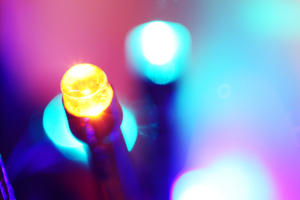Importance of Display Contrast Measurement in Cockpit Instrumentation

Cockpit instrumentation in the aerospace industry has evolved over the past decades. In the past, control panels had backlit gauges, switches, and knobs, whereas now, you are more likely to see an array of flat panel screens. There must be consistent light and color emitting from these panels to reduce eyestrain, ease the interpretation of data, and decrease distractions. In addition, they are comfortable to view equally in daylight and as well as at night. Two key measurements are Luminance (a measure of brightness) and Display Contrast (the ratio between light and dark).
Luminance (Brightness) is a photometric measure of the luminous intensity per unit area of light traveling in a given direction. Brightness is defined as the luminance of the brightest component (white color) and measured in candela per square meter (cd/m2 = nit) or foot-lamberts (1fL=3.426 nits). Typically, display luminance varies from 100 nits in most office monitors up to 1000 nits in front projection systems.
There are varieties of units used for luminance. In most countries, the most common unit for luminance is candela/square meter (cd/m2). However, in the U.S., the most common unit is the foot-lambert (fL); 1 foot-lambert (fL) equals 1/π candela/square foot, or 3.426 cd/m2. Professionals in the industry often use the term nit (nt). 1 nit unit is equivalent to 1 cd/m2.
You can use a luminance meter such as the LS-150 or LS-160 to measure luminance.
Display Contrast is the ratio between the brightest colors (in most cases white) and the darkest color (in most cases black) that the monitor can produce. Where there is no industry standard in measuring contrast, the generally accepted process is to measure parts of a screen and either take the average or highest white and the average or lowest black and express it in ratio form bright:dark. For example, if a screen has a bright luminance of 150 nits and a dark luminance of 1 nit, the contrast ratio would be 150:1.
With newer high performance, OLEDs with darker blacks produce much wider ratios. Hence, if a monitor can output 7500 nits with a white screen and 0.010 nits with a black screen, it would have a contrast ratio of 750,000:1. A higher contrast produces more in-depth images with better screen quality, giving richer colors that make it easier to interpret images and data. A decent LCD screen might have a contrast ratio of 1,000:1. The contrast on an OLED display is far higher, at around 4000:1, with ultra-high-end units beginning to get close to 1,000,000:1. When an OLED screen shows black, its pixels produce almost no light whatsoever.
A display’s contrast ratio is one of the most important performance measurements. In addition, it will be the most noticeable difference between the two displays in a side-by-side comparison.
A spectroradiometer such as one from the CS-3000 series is best for measuring contrast. With high-end spectroradiometers, can read luminance levels as low as 0.0001 cd/m2 when used @ 1 degree setting and read highest luminance level 10,000,000 cd/m2 when used @ 0.1 degree setting.











